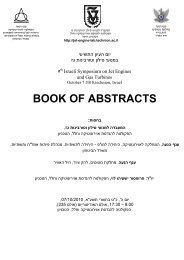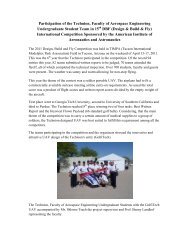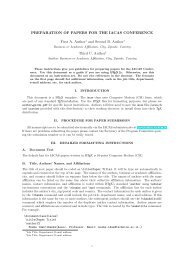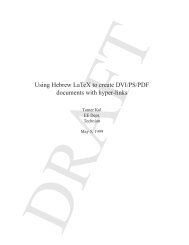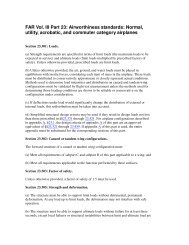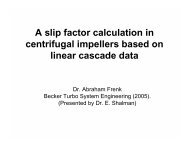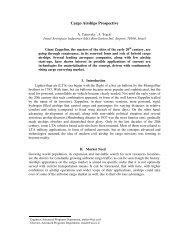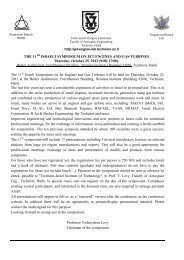A Century of Ramjet Propulsion Technology Evolution - Faculty of ...
A Century of Ramjet Propulsion Technology Evolution - Faculty of ...
A Century of Ramjet Propulsion Technology Evolution - Faculty of ...
Create successful ePaper yourself
Turn your PDF publications into a flip-book with our unique Google optimized e-Paper software.
44 FRY<br />
It uses a DR IRR cycle and is commonly attributed with starting<br />
the ramjet race. The October 1973 Yom Kippur War convincingly<br />
demonstrated the effectiveness <strong>of</strong> the IRR in tactical missiles. With<br />
employment <strong>of</strong> a DR cycle, the Russian SA-6 SAMs inflicted sharp<br />
losses on the Israeli fighters in 1973 and played prominently in the<br />
1999 air campaign in Yugoslavia.<br />
Before 1965, ramjet-powered missile systems, such as the U.S.<br />
Air Force Navaho and Bomarc, the U.S. Navy Talos, and the Russian<br />
SA-4 were externally boosted by a separable rocket system. This led<br />
to relatively large missiles, which were limited to launch from the<br />
ground or a ship. Launch from an aircraft or greater maneuvering<br />
capability, which require a smaller missile, became feasible with the<br />
development <strong>of</strong> the integral rocket–ramjet concept. In these more<br />
recent ramjets, the rocket booster was integrated within the ramjet<br />
combustor, thereby saving considerable volume (Fig. 19). 37<br />
As with the axisymmetric normal shock tandem-boosted ramjet,<br />
the flow-turning inlet integral rocket ramjet has undergone cyclical<br />
periods <strong>of</strong> interest, from the supersonic chemical propulsion<br />
low-altitude supersonic ramjet missile (SCP/LASRM) in the mid-<br />
1960s to advanced low-volume ramjet (ALVRJ) in the early 1970s<br />
to advanced strategic air-launched missile–propulsion test vehicle<br />
(ASALM–PTV) in the late 1970s to the SLAT in the early<br />
1990s. <strong>Ramjet</strong>-powered air-to-surface missile exploratory development<br />
and flight testing began in the mid-1960s and extended<br />
through the 1980s. Solid and liquid IRR propulsion were selected<br />
for such applications. Beginning in 1964, the U.S. Air Force sponsored<br />
SCP/LASRM, an air-launched IRR supersonic missile development<br />
program. LASRM, the first low-volume IRR design, was<br />
flight demonstrated in the mid-1960s. The flight vehicle employed<br />
four aft-mounted, two-dimensional, inward turning inlets, was fueled<br />
with a heavy hydrocarbon, Shelldyne, and was designed to<br />
operate at Mach 2.5 sea level. The LASRM physical configuration<br />
is compared with contemporary systems in Fig. 19. Whereas flight<br />
tests were successful, a small operational envelope was experienced<br />
due to inlet unstart conditions.<br />
France developed the SE-X-422 demonstrator (Fig. 20) from 1965<br />
to 1967 for a long-range cruise missile application. The design employed<br />
an LRFJ with a single inlet located aft (Fig. 20). Three successful<br />
flight tests were conducted in 1967 and achieved Mach 2 at<br />
30,000 ft.<br />
The Navy ALVRJ vehicle (Fig. 21) was an LFIRR configuration<br />
<strong>of</strong> the late 1960s. The major program goal was to demonstrate controlled<br />
free flight at Mach 2.5–3 to ranges <strong>of</strong> 25–100 n mile with sufficient<br />
margin to provide for terminally effective tactical payloads. 22<br />
It was similar in size and configuration to LASRM, except the four<br />
aft-mounted side inlets were outward turning, which provided better<br />
angle-<strong>of</strong>-attack operation, thereby permitting operation from sea<br />
Fig. 19 Early ramjet systems history (1945–1980).<br />
Fig. 20 French SE-X-422 flight-tested missile (1965–1967).<br />
Fig. 21 U.S. ALVRJ flight-tested missile (1968–1975).<br />
level to intermediate altitudes. The JP-5-fueled ramjet employed<br />
a solid propellant carboxyl-terminated polybutadiene/ammonium<br />
perchlorate (CTPB/AP) integral booster, a DC93-104 insulation system,<br />
and an ejectable nozzle. Seven flight tests were flown, most<br />
between 1975 and 1979. Initial flight tests used flight weight heatsink<br />
hardware, with later testing involving the DC93-104 insulation<br />
system. All goals, objectives, and specified data points were substantially<br />
achieved with the major contribution being the first successful<br />
demonstration <strong>of</strong> the in-flight ramjet takeover for an IRR design. A<br />
number <strong>of</strong> other advanced development efforts to support a technology<br />
base for a supersonic tactical missile (STM) were conducted<br />
in parallel with the ALVRJ effort. Successful programs were conducted<br />
in the areas <strong>of</strong> terminal guidance, midcourse guidance, and<br />
warheads. Whereas the Navy approved an STM concept directed<br />
toward tactical land targets, Congress canceled subsequent development<br />
based upon a review <strong>of</strong> tactical needs and requirements.<br />
Russia began development <strong>of</strong> the SS-N-19 Shipwreck supersonic<br />
long-range antiship missile (Fig. 22) in the early 1970s. First thought<br />
to use turbojet propulsion, it was recently revealed 38 to be liquid fuel<br />
ramjet-powered. Made operational in 1981 as the first sublaunched






